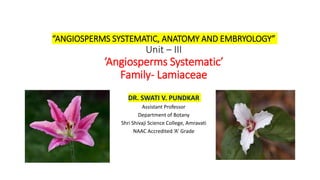
Lamiaceae
- 1. “ANGIOSPERMS SYSTEMATIC, ANATOMY AND EMBRYOLOGY” Unit – III ‘Angiosperms Systematic’ Family- Lamiaceae DR. SWATI V. PUNDKAR Assistant Professor Department of Botany Shri Shivaji Science College, Amravati NAAC Accredited ‘A’ Grade
- 2. Family- Lamiaceae Lamiaceae, formerly called Labiatae, the mint family of flowering plants, with 236 genera and more than 7,000 species, the largest family of the order Lamiales. Lamiaceae is distributed nearly worldwide, and many species are cultivated for their fragrant leaves and attractive flowers. The family is particularly important to humans for herb plants useful for flavour, fragrance, or medicinal properties.
- 3. Most members of the family are perennial or annual herbs with square stems, though some species are woody shrubs or subshrubs. The leaves are typically simple and oppositely arranged; most are fragrant and contain volatile oils. The flowers are usually arranged in clusters and feature two- lipped, open-mouthed, tubular corollas (united petals) with five-lobed bell-like calyxes (united sepals). The fruit is commonly a dry nutlet. Best known for its sharp fragrance is rosemary (Rosmarinus officinalis), a Mediterranean species. Also Mediterranean is lavender (Lavandula officinalis), with fragrant blue to lavender flowers in leafless spikes.
- 5. Primitive characters: 1. Some members are perennial shrubs. 2. Leaves simple. 3. Flowers hermaphrodite, hypogynous, coloured and scented. 4. Pollination by insects. Advanced characters: 1. Plants mostly herbaceous. 2. Leaves exstipulate, opposite or whorled. 3. Flowers in distinct inflorescence. 4. Flowers zygomorphic and in some unisexual (Iboza). 5. Calyx gamosepalous and bilabiate. 6. Corolla gamopetalous and bilabiate. 7. Stamens epipetalous and reduced to 2. 8. Gynoecium bicarpellary, syncarpous, axile placentation. 9. One ovule per loculus. 10. Fruit simple. 11. Seeds non-endospermic.
- 7. •black horehound (Ballota nigra) •bugleweed (genus Ajuga) •catnip (Nepeta cataria) •coleus (various genera and species) •dragonhead (genus Dracocephalum) •false dragonhead (genus Physostegia) •germander (genus Teucrium) •horehound (Marrubium vulgare) •lavender (genus Lavandula) •lemon balm (Melissa officinalis) •mint (genus Mentha)peppermint (M. ×piperita) •spearmint (M. spicata) •genus Ocimumbasil (Ocimum basilicum) •holy basil (O. tenuiflorum) •genus Origanummarjoram (O. majorana) •oregano (O. vulgare) •rosemary (Rosmarinus officinalis) •salvia (genus Salvia)chia (S. hispanica) •winter savory (S. montana) •self-heal (genus Prunella) •thyme (Thymus vulgaris)
- 8. Characters of Lamiaceae: Sweet aromatic smell due to essential oils present in sessile glandular hairs; stem rectangular in cross section, leaves opposite decussate rarely alternate, simple, exstipulate with hairs; inflorescence verticillaster; flowers zygomorphic, hermaphrodite, hypogynous, bracteate; calyx gamosepalous, persistent; corolla bilabiate; stamens 4 epipetalous, didynamous; gynoecium 2 four celled by false septum, syncarpous, axile placentation, gynobasic style, seated on lobed disc; fruit schizocarpic carcerulus.
- 9. A. Vegetative characters: Habit: Plants are mostly aromatic herbs or shrubs (Leonotis, Pogostemon). Tree habit is found in the Brazilian genus Hyptis and climbing habit in American species of Scutellaria. Root: Tap, branched, rarely adventitious (Mentha).
- 10. Stem: Aerial, herbaceous, rarely woody, erect or prostrate, quadrangular, hairy, branched, solid or hollow, sometimes underground suckers (Mentha).
- 11. Leaves: Opposite decussate, rarely whorled, simple, petiolate or sessile, exstipulate, hairy with aromatic smell, entire, pinnatifid (Perovskia), unicostate reticulate venation.
- 12. B. Floral characters: Inflorescence: Very commonly verticillaster consisting of a pair of condensed dichasial cymes at each node; often the verticillasters are grouped together in a thyrsus form; rarely solitary (Scutellaria).
- 13. Flower: Pedicellate or sessile, bracteate, complete, zygomorphic rarely actinomorphic (Mentha, Elsholtzia), hermaphrodite, rarely unisexual (Nepeta, Thymus), pentamerous hypogynous.
- 14. Calyx: Sepals 5, gamosepalous, bilabiate (Salvia, Thymus) campanulate (Teucrium), persistent, valvate or imbricate aestivation. When a bilabiate calyx is present the arrangement of the sepals may be (1/4) as in Ocimum or (2/3) as in Calamintha.
- 15. Corolla: The corolla possesses a tubular base which widens towards the mouth. Petals generally 5, gamopetalous and the five teeth are sub-equal and mostly bilabiate. In Mentha a four lobed corolla arises due to the fusion of two upper teeth. When a distinct bilabiate condition is found the arrangement of the petals may be gamopetalous 2/3 i.e. two petals in the posterior upper lip and three in the anterior lower lip (Salvia, Nepeta, Leucas etc.). In Ocimum, Coleus, Plectranthus etc. the petals arrangement is gamopetalous 4/1 i.e. four petals in the posterior upper lip and only one petal in the anterior lower lip. In extreme cases the arrangement may be gamopetalous 0/5 i.e. all the five petals forming the lower lip so that the corolla becomes one lipped. Aestivation in the petals is valvate or imbricate.
- 16. Androecium: Typically only 4 stamens, didynamous (2+2) and posterior stamen is reduced or represented by a staminode; in Calamintha only two perfect stamens are found, two are imperfect and the fifth reduced. In Salvia only two stamens on the anterior side are found; they are characterised by peculiarly long connectives which help in insect pollination stamens generally introrse and dithecous.
- 18. Gynoecium: Bicarpellary, syncarpous, superior, situated on hypogynous honey secreting disc; bilocular becomes tetralocular by the formation of false septum; axile placentation, one ovule in each loculus; style gynobasic (arising from the base of the ovary), stigma bilobed. The gynoecium character is thus uniform without any variation.
- 20. Fruit: Usually schizocarpic carcerulus or achenes or nutlets rarely drupaceous.
- 21. Floral- formula:
- 22. Economic Importance of Lamiaceae: 1. Food: Tubers of Stachys sieboldi are edible. Leaves of Mentha viridis, Ocimum basilicum, Melissa officinalis etc. are used as condiments. 2. Medicinal: Many plants of this family are used in medicines. Ajuga bracteosa, Leucas cephalotes are used in fever. Mentha piperata and Thymus serphyllum give Menthol and Thymol respectively, which are extensively used in medicines. Leaves of Ocimum kilimandus charicum give camphor. Ocimum sanctum and other species of Ocimum are used in various ailments. 3. Ornamental: Several species of Salvia, Coleus, Ajuga, Leonotis, Dracocephalum, Thymus, Lavandula etc. are cultivated in gardens for ornamental purposes. 4. Perfumes: Aromatic oil is extracted from Thymus, Lavandula (Lavender oil), Rosmarinus (Rosemary oil), Calamintha, Pogostemon etc. 5. Dye: Fruits of Lycopus europaeus yield red dye.